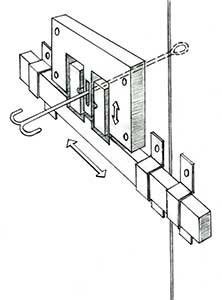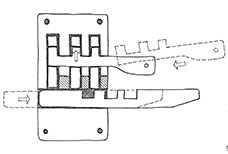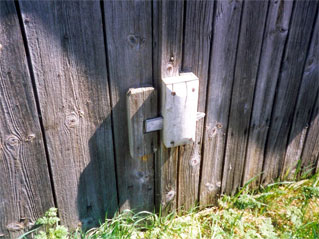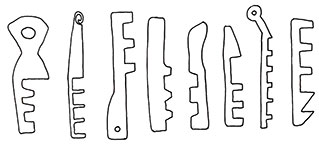Celtic locks, type 1
Wooden pin tumbler locks with an iron key. The anchor-shaped key was inserted into the lock slot and turned a half turn, so that the two points fit into the wooden pins that held the bolt in place and lifted them. A strap was then used to draw the bolt.
 |
| Viking-Era key from the County Museum of Gotland. The key with the anchor-shaped bit is 26.2 cm and was used for locks with wooden pin tumblers. Sketch by the author. |
As early as the Viking Era, people in many parts of Northern Europe began using pin tumbler locks based on the Roman and Celtic locks of wood and metal. The pins or dowels fell from their own weight and held the bolt in place. The wooden key lifted the dowels out of the notches in the bolt so that it could be drawn.
 |
| Wooden pin tumbler lock with iron key. Sketch by the author. |
Wooden locks with wooden tumblers
Wooden pin tumbler locks have been used in simple buildings in Scandinavia from the Viking Era until well into the 20th century. This type of lock had gradually migrated north from ancient Southern Europe. Since the locks were placed on the outside of the doors or walls, they were extremely vulnerable.
 |
| Wooden pin tumbler lock with wooden key and bolt. Sketch by the author. |
The lock consisted of a square block of beech or birch with grooves for two, three, or four tumblers, bolt, and key. They were inexpensive and easy to replace when they broke. The wooden tumblers blocking the bolt’s movement and the key were made of the same material. The key had as many teeth as the lock had tumblers. To open the lock, the key was inserted in the side of the lock body, lifting the tumblers hidden inside so that the bolt could be drawn. This type of locks were not a local phenomenon; they were found in Sweden, Norway, Denmark, Finland, Estonia, Latvia, Germany, Switzerland, Holland, Greece, Spain, and Cyprus. They are even still in use in some parts of the African continent.
 |
| Pin tumbler lock in use in Småland in 2005. Photo by the author. |
 |
| Wooden (and iron) keys for pin tumbler locks. From the left: Lund, Jämtland (iron), Småland, Denmark, Denmark, Estonia, Norway, and Asia Minor. Sketch by the author. |